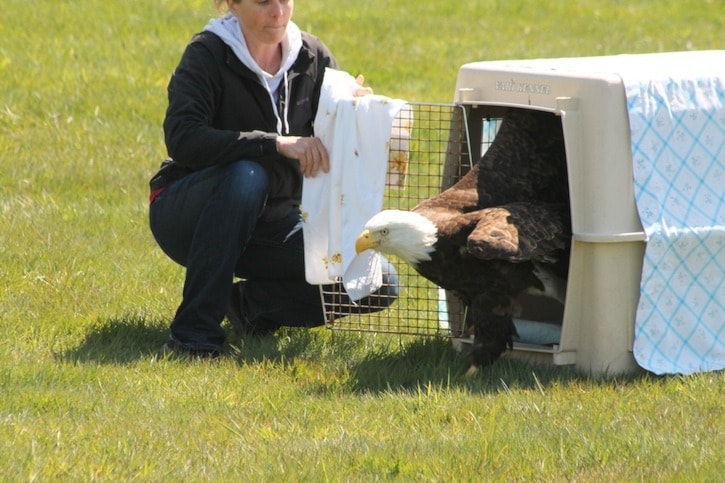On March 22, a few members of the Sooke community were surprised to find an adult Bald eagle resting on the ground, seemingly unwell and approachable. BC SPCA Wild ARC was contacted immediately and following a successful herding in an enclosed area, Jeff Krieger from Alternative Wildlife Solutions volunteered his time to contain and transport the large bird to Wild ARC’s facility in Metchosin.
Upon arrival, the wildlife rehabilitation staff performed a full physical examination which revealed that the eagle was suffering from what appeared to be the result of eagle rivalry. She was weak and had several puncture wounds and abrasions on her chest, abdomen, and both legs. Her right leg was also swollen and edematous, and she had limited use of her foot.
The eagle also had a brood patch, an indication that she would have been incubating eggs. During breeding season, staff takes into consideration the fact that injured adults may have young to care for. In some cases, the staff may decide to release the animal as soon as it would be able to go back to tending to their young even though in other circumstances, staff would keep them in care until they have fully recovered. In the case of this adult female, a premature release could not be considered due to the fact that she did not have full use of her right talons, which is crucial to perform a wide range of things such as hunting and perching. Both male and female Bald eagles care for their young, so staff hoped that in this case the male would provide care until the female was able to return.
As part of the diagnostic procedure, blood was collected to be analyzed to assess her condition and radiographs were taken to confirm that the leg injury involved only soft tissues. A splint was then applied onto her right foot to provide support and full range of motion of the halux, the birds’ equivalent of a human thumb. She was initially kept in a small enclosure to minimize activity, allowing her to recover slowly. She had to be hand fed for several days before she started self feeding. Fluid therapy, anti-inflammatories, antibiotics, and homeopathic remedies were all part of her treatment plan. As she regained strength, she was transitioned to larger enclosures and became increasingly strong and difficult to handle by staff. Once the splint was removed, it was still unclear if she would regain full use of her foot. To minimize handling, staff had to provide her with the opportunity to do her own physiotherapy. Perches of various sizes allowed her to strengthen her foot while exercising by grabbing onto them. The last stage of her rehabilitation process was in Wild ARC’s largest flight aviary, where she was able to fly and rebuild flight muscle and regain stamina prior to release.
On April 15, after just over three weeks of care, the nearly 6 kg Bald eagle was brought back to the location she was rescued from. Once the door of the kennel opened up, she promptly ran out and stood in the field for a few minutes before taking flight, making large circles while raising high up into the sky. As the release team was leaving the area, she was back above the release site, tumbling down towards the ground while her talons were clenched onto another adult Bald eagle’s talons. They appeared to have landed in an adjacent field. The rehabilitation team ran to the suspected landing site, but as they were approaching, one of the eagles was seen flying away into the distance, shortly followed by the second one, who flew off in the opposite direction. Breeding season also means that animals are more territorial. Unfamiliar adults are not tolerated within an individual or a pair’s territory and the message is made very clear to intruders. Even though it was her territory, three weeks away from it can have changed the dynamic in the area.
It is uncertain if she will remain in the same area or if the nest will be successful, but what we do know is that without the help of the community and the professional care Wild ARC’s team was able to provide her with, her survival would have been unlikely. If you would like to learn more about Wild ARC and how you can support our work, please visit us at www.wildarc.com or contact us at 250-478-9453 with any questions concerning wildlife.
Christina* Carrières, RVT, CWR
Senior Wildlife Rehabilitator
